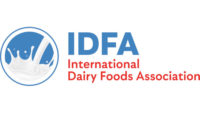
Taking Its Time
by Shonda Talerico Dudlicek
The aseptic packaging market is making a gradual climb
while waiting to finally click with more consumers.
It would be too simple to
say that significant natural disasters and rising energy costs have
contributed to the rise in popularity of aseptic packaging. Aseptic
packagers say these unique containers have been gaining momentum in the
United States over the past few years.
“It is true that recent events like increased
hurricane activity or rising energy costs have brought more attention to
our carton core packaging,” says Giovanna Prestes Lemos, marketing
and communication manager, Tetra Pak Inc., Vernon Hills, Ill. “But
carton aseptic packaging has been growing in the U.S. for many years now,
suggesting that the interest is not just a short-term phenomenon.
Manufacturers and consumers are seeking out affordable sustainable
packaging solutions.”
Tetra Pak supplies complete integrated processing,
packaging and distribution lines as well as stand-alone equipment, tested
to ensure optimal function.
“Aseptic processing and packaging are strategic
technologies that companies enter to differentiate themselves from
others,” says Danny Beard, director of sales, International
Dispensing Corp., Hanover, Md. “The cost of entry is significant, but
the marketing pay-offs should be realized in a very short period of time.
All that is to say that recent events are not the real driver for aseptic
processing.”
IDC manufactures the Fresh Flow Tap, a FDA-certified
aseptic one-way dispensing tap for bag-in-box packages. The one-way aseptic
tap ensures beverages remain sterile and hygienic throughout the life of
the product.
“Bag-in-box aseptic packaging is gaining momentum
in the United States, particularly over the last two to three years,”
says Paul Dean, commercial director-Food Products, Scholle Packaging Inc.,
Northlake, Ill.
As the pioneer of low-acid aseptic bag-in-box systems
more than 30 years ago, Scholle has been reacting to this demand by
developing new aseptic connector and dispensing fitments combined with
high-speed low acid aseptic filling technology.
Aseptic Market
The growth of aseptic packaging sales is outpacing the
overall food packaging industry, Prestes Lemos says.
Fluid milk is a large market for aseptic packages, but
there’s also potential for coffee creamers, culinary cream, sweet
condensed milk, milk-based desserts, yogurt drinks, flavored milk, dairy
drinks, nacho cheese, soy-based beverages, teas and coffee products.
“Fluid milk is a small part of the total,”
Beard says. “Practically all beverage types — juices,
isotonics, flavored waters, functional beverages, etc. — that can
benefit are being considered for aseptic packaging, along with fruit and
vegetable concentrates, sauces, cooking stocks and nutraceuticals. The
opportunities continue to grow as new beverages and ready-to-eat products
are developed.”
This year, 100 percent fruit juices, isotonics, iced
teas and lemonade in aseptic packaging will hit the market, says Gary
Allanson, IDC president and chief executive officer.
“Growth in the U.S. markets for aseptic
packaging has been limited by packaging innovations that offer consumers
options such as convenience, pack size, re-sealing and shelf-life,”
Allanson says.
Aseptic packagers agree that dairy processors
aren’t using and marketing aseptic packaging to its fullest
potential.
“In many ways, the fullest potential of milk is
challenged by government regulations,” Prestes Lemos says.
“Milk products are forbidden to use certain descriptors and language
whereas other beverages like carbonated soft drinks are not. This impacts
the ability to market aseptic milk as well as traditional milk.
Nevertheless, there are some aseptic milk brands that do a fine job in
marketing.”
New Technology
Innovation is key in aseptic packaging, and packagers
are hard at work to meet processors’ and consumers’ needs.
For Tetra Pak, the next big trend is the aseptic
carton bottle, Prestes Lemos says. Tetra Aptiva Aseptic combines the taste
and nutritional value of aseptic carton packaging with the appeal of
plastic bottles, resulting in a package that is both a bottle and carton.
Tetra Aptiva Aseptic is suited for the fast-growing market of on-the-go
beverages distributed through vending machines, convenience stores,
supermarkets and other retail channels. Offering a semi-cylindrical shape,
the package has a wide, easy-to-drink-from opening with a resealable screw
cap applied onto a plastic top.
“The Tetra Wedge Aseptic Clear 200 S, still in
market development, is the world’s first aseptic transparent stand-up
pouch,” Prestes Lemos says. “Designed especially for
kids’ on-the-go drinks, it has a unique soft and squishy feeling and
see-through look, which 6- to 12-year-olds find fun and cool, according to
market research in North America and Europe.”
Scholle has developed the Sentry Safe lock system.
“This provides customers with the very best method of packing and
dispensing aseptically packaged products along with our aseptic filling
equipment,” Dean says.
Allanson says IDC’s Fresh Flow Tap ensures that
every drop of product is consumed. “Imagine never having to throw
away another dairy product, fruit juice or coffee beverage because it went
bad after the package was opened,” he says. “Given the rising
energy costs and heightened safety concerns in the supply chain this
packaging innovation has the potential to set new standards for aseptic
dispensing and become ubiquitous.”
Consumers want safety, product quality and value,
Allanson says. “They want to know that the package is tamper-evident
and will keep the product safe through the supply chain. They want more
products that are organic or natural and they want fewer preservatives in
everything they consume. Aseptic processing delivers a better product than
a hot-fill or retort process. They want value — as gas prices, home
heating oil, and interest rates continue to climb, getting every penny out
of the food and beverage packaging will be key.”
ESL Market
Companies like Tetra Pak and Uniloy Milacron —
which originated the lightweight, handled, plastic milk jug in 1963 —
also meet demand for extended-shelf-life milk in HDPE bottles in countries
with limited refrigeration.
With 3,800 in use worldwide, Uniloy’s
reciprocating blow-molding machine has become the industry standard, says
Richard Smith, director of sales and marketing at the Tecumseh, Mich.-based
company. “It’s simply the best technology for producing a
lightweight three-layer HDPE container at the lowest cost.”
Uniloy introduces the first reciprocating blow molding
machine capable of producing three-layer ESL bottles.
“ESL outside the U.S. is a huge market due to
not having the type of cold chain we enjoy here,” Smith says.
“ESL in the U.S. will grow but will be slowed by the preference of
our palates for fresh milk. ESL fluid milk outside the U.S. is a huge
market, however, liquid yogurt and soy-based drinks also use this
technology. However, I see no reason why other types of dairy could not use
this technology also.”
A Lasting Impression
The often-made argument that consumers won’t
accept aseptic is one that’s not lost on packagers.
“We aspire to add incremental sales to the dairy
industry by proving value to consumers where refrigerated products cannot
go. We are not going to fool ourselves or anyone else for that matter that
we can compete against plastic gallons of white milk,” Prestes Lemos
says. “However, consumers who do purchase aseptic milk are very loyal
to the product and value it. Consumers don’t consume carbonated soft
drinks warm either, yet millions buy warm cases of it everyday. Generally
speaking, moms buy aseptic milk for their kids to give them a healthy
beverage, or smaller households buy it for the pantry-loading
convenience.”
Because the cost of aseptic milk also inhibits its
growth for traditional fluid milk opportunities, the much bigger
opportunities within the dairy industry are for more value-added products
such as drinkable yogurts, dairy-based coffee beverages and soy milk, Beard
says.
Dean says in bag-in-box applications, consumers are
already buying or using products that have been aseptically processed and
packed. “In some applications, the product is stored at ambient
temperature until ready for dispensing and then may be chilled — for
example, milk or other dairy products — or heated — for
example, nacho cheeses.”
Allanson speaks of Meridian, Idaho-based The Good Cow
Co.’s patented pasteurization process that enables aseptically
prepared milk to taste fresh paired up with IDC’s dispensing
innovation.
“Given time and the correct marketing push,
consumers will accept shelf-stable milk if the taste, quality and use-life
are superior to traditional cartons of milk,” he says. “The
same question faced the milk industry when it shifted from glass jugs
to paper cartons to plastic jugs. It simply boils down to taste,
quality and the value proposition to consumers.”
Shonda Talerico Dudlicek is a freelance journalist and
a former managing editor of Dairy Field.
ASEPTIC
Aseptic packaging means filling a sterilized package
with a sterile food under a confined hygienic environment. In the aseptic
packaging process the product passes from the ultra-high-temperature (UHT)
treatment in a closed system to the packaging machine. There it is packed
under aseptic conditions in a packaging material, which is sterile and
keeps out light and air. Aseptic technology keeps food safe, fresh and
flavorful for at least six months without refrigeration or preservatives.
ESL
Extended-shelf-life (ESL) milk is heated to a
temperature between 185 to 260.6 degrees F for a minimum of two seconds.
ESL milk can be stored refrigerated for up to 21 days and is as nourishing
as pasteurized milk. Longer shelf life is based on an unopened package and
refrigeration.
SOURCE: www.tetrapak.com
$OMN_arttitle="Taking Its Time";?>
